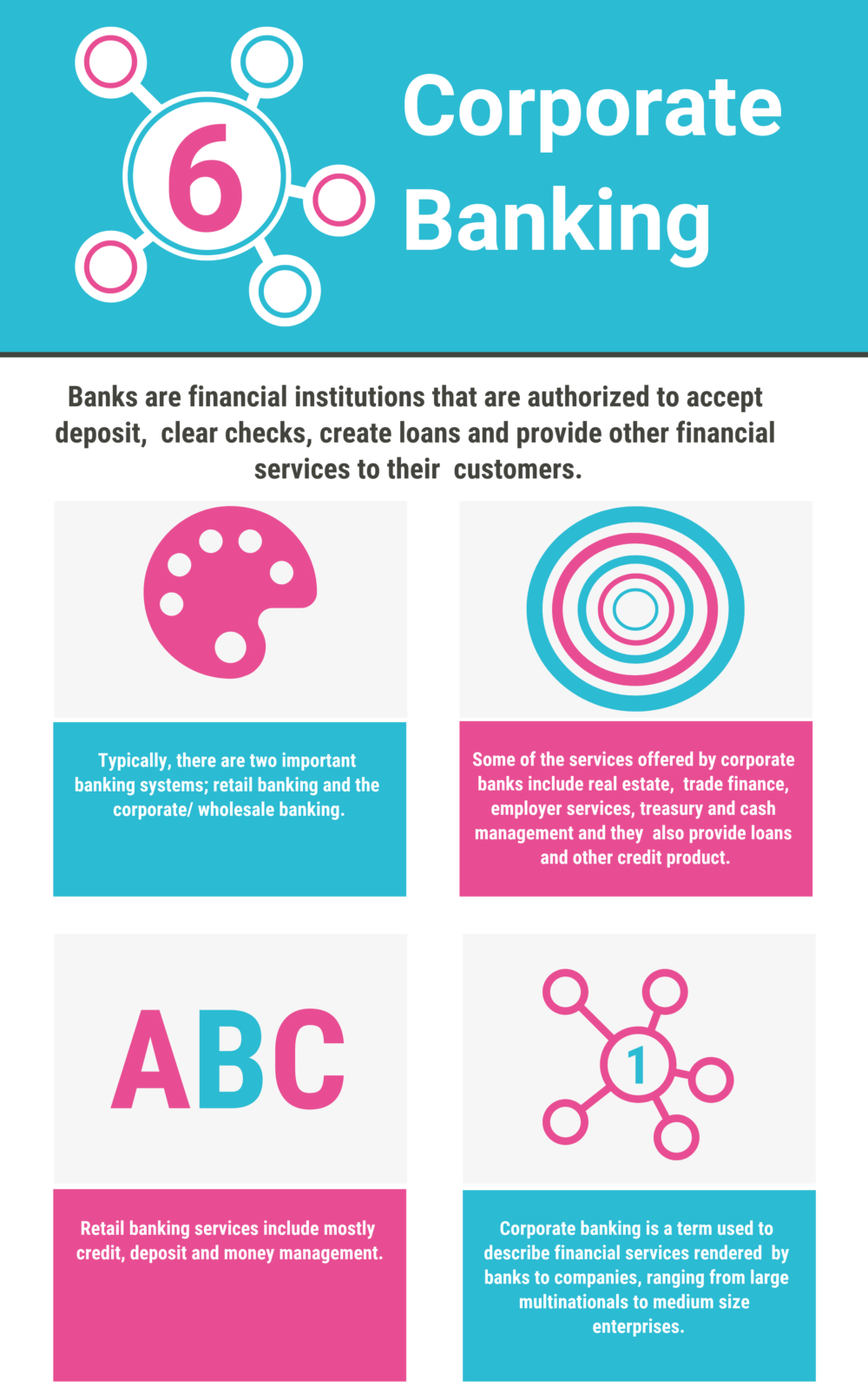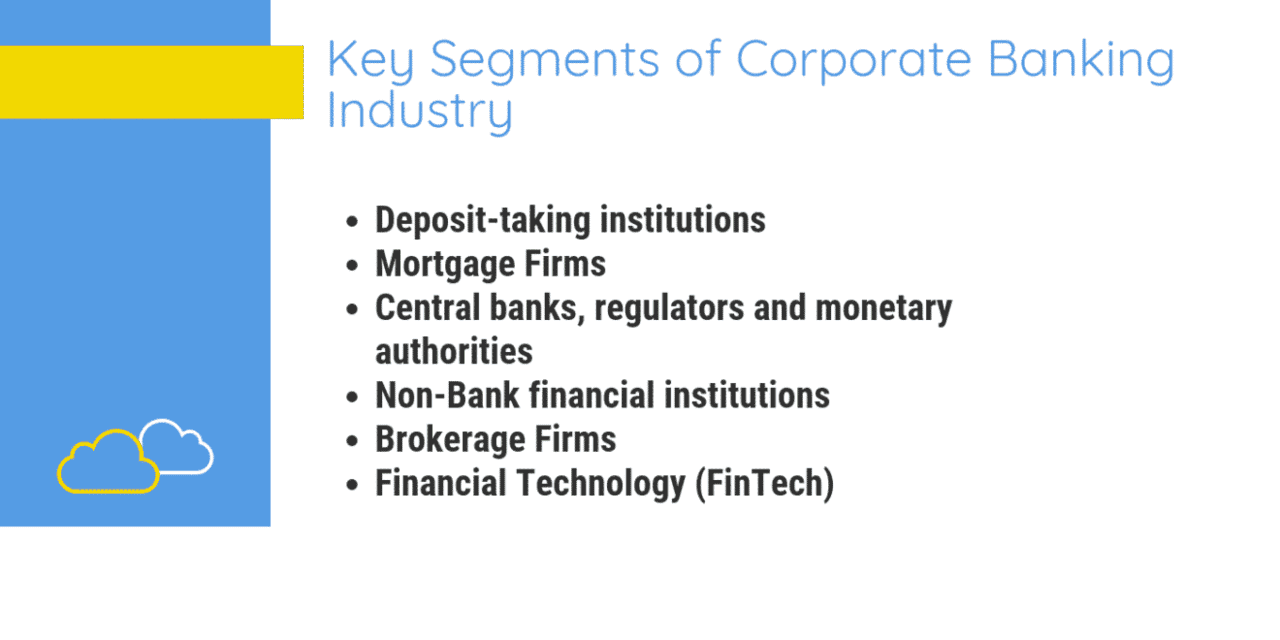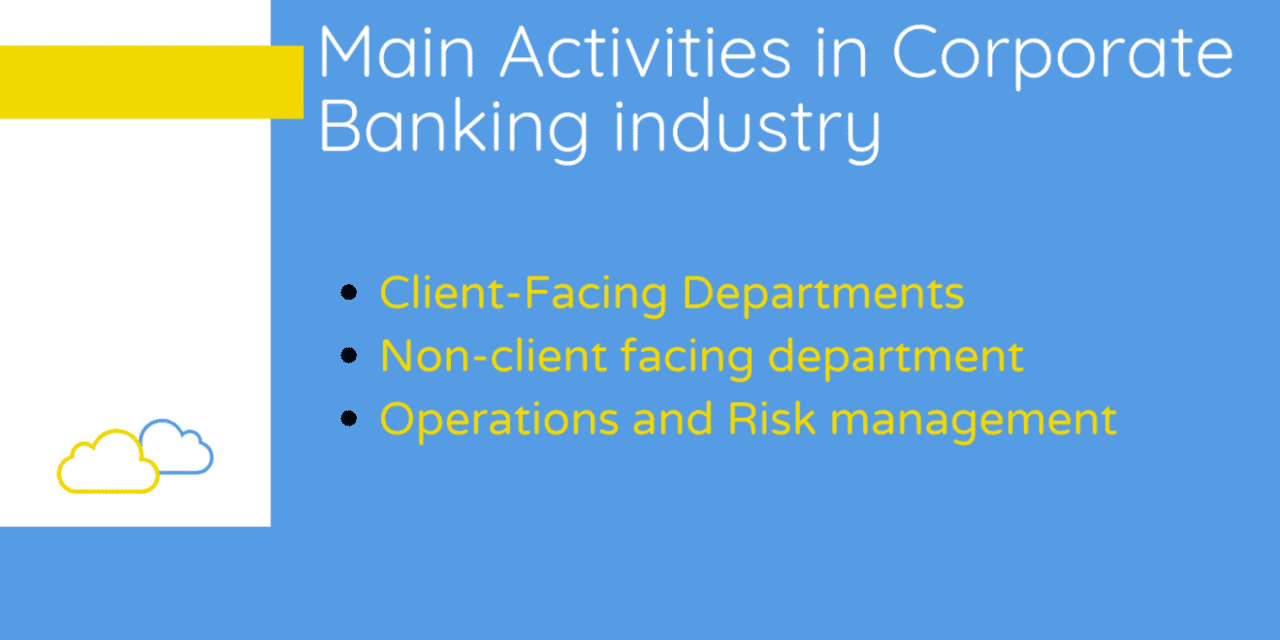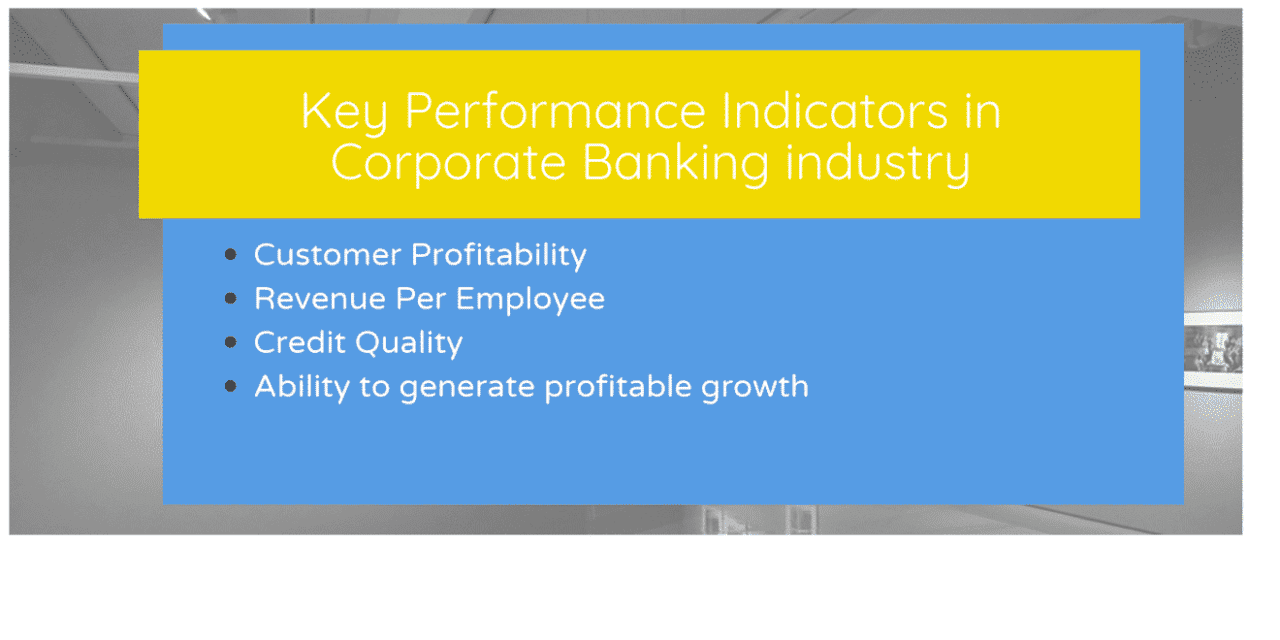All About Corporate Banking Industry: Key Segments, Value Chain and Activities

Banks are financial institutions that are authorized to accept deposit, clear checks, create loans and provide other financial services to their customers. They act as middlemen in financial transactions and also provide loans to their clients.
Loans are provided to organizations or individuals at an extra cost known as interest. Interest on loans are usually a function of the principal, and an assessment of the borrowers’ ability to pay back the loan. One approach used by banks to determine whether not to approve a loan is the credit scoring system. Credit scoring is a ranking system that shows how likely it is for a person to default on their loan.
Some other services that banks offer to their customers include cash management, overdraft, consultancy, risk minimization, foreign exchange, credit cards and lots more. These services help buyers and sellers facilitate business transactions with relative ease.
Banks generate revenue in different ways, but majority of their income comes from interests on loans, money deposits, share equity, debts, consumer lending and other services known as transaction revenue. Transaction revenue is a term used to refer to income earned when there is an exchange of products, services or asset for cash or credit.
Typically, there are two important banking systems; retail banking and the corporate/ wholesale banking. Retail banking, also known as consumer banking comprises of all the financial services rendered by a bank to individuals, families and small-sized businesses. Retail banking services include mostly credit, deposit and money management. Whereas, corporate banking is a term used to describe financial services rendered by banks to companies, ranging from large multinationals to medium size enterprises. It is widely regarded to as wholesale banking.
Some of the services offered by corporate banks include real estate, trade finance, employer services, treasury and cash management and they also provide loans and other credit product. Asides from these two banking systems, a few banks incorporate investment banking into their system.
Investment banking is a division of banking that looks to raise money for their clients in the capital market. Investment Bankers advise their clients before every major financial decision is taken, and also assist them with mergers. Other investment banking services include; acting as a broker for institutional clients and acting as an intermediary between an issuer of securities and the investing public.
Although, most banks focus on retail and corporate aspects of banking, the few ones that integrate all three aspects of banking are known as universal banks.
What are the Key Segments of Corporate Banking Industry?

What are the Key Segments of Corporate Banking Industry
- Deposit-taking institutions: Deposit-taking institutions make up a key segment in the corporate banking industry. It is made up of commercial banks, credit unions and co-operatives. They range from global banks with complex operations, simple credit unions to community cooperative societies depending on the size of the institution. These financial institutions allow their clients or members to deposit money with the prospect of a certain percentage of interest after a period of time.
- Mortgage Firms: Mortgage firms are firms involved in servicing mortgage loans for residential and commercial properties. Mortgage companies are different from mortgage brokers in that they fund the loans with their own capital. They then seek out a potential borrower in need of funding.
- Central banks, regulators and monetary authorities: Central banks, regulators, monetary authorities are institutions that manages an economy’s monetary policy, issues currencies, regulates and supervise commercial banks. They also provide financial and banking services for government agencies and commercial banks. The goal of these institutions includes preventing inflation, reducing unemployment to the barest minimum and also stabilizing the nation’s currency. Central banks and other monetary authorities also act as last resorts for other banks when they run into financial crisis.
- Non-Bank financial institutions: Non-bank financial institutions are institutions that provide some of the same services as banks but technically, they are not banks. Examples of non-bank financial institutions include savings and loans, shadow banks and sometimes credit unions.
- Brokerage Firms: Brokerage firms are often regarded to as brokerage and their main duty is to connect two businesses in order to facilitate a financial transaction. Banks generate income from brokerage in form of compensations when a transaction is completed. Brokerage firms offer other services asides carrying out a bond or stock trade, they also research the stock market in order to provide their clients with the appropriate recommendations. The different types of brokerage firms include discount brokerage, full service brokerage, online brokerage, independent brokerage and others
- Financial Technology (FinTech): Financial Technology represents new technology providers with innovations that aim to rival conventional methods of delivering banking services. It includes the automation of services such as depositions and money transfer. Examples of financial technology include internet banking, Unstructured Supplementary Service Data (USSD), crypto currency and lots more.
What are the Corporate Banking Industry Value Chain?
The corporate banking industry offers a lot of important services to its clients. corporate banking services are the main reasons why corporate banks are established and they include:

What are the Corporate Banking Industry Value Chain
- Cash Management Services: Cash management is a marketing term used to describe cash related services offered to large companies by corporate banks. They provide solutions that automates various business processes, streamline daily task and also control cost effectively for domestic and international operations.
- Trade Solutions: Corporate banks offer Trade solutions such as trade loans, trade collections, letters of credit, bonds, guarantees and indemnities to companies in a bid to optimize their trading operations.
- Private equity financing: Private equity is a term used to describe investments made directly to private companies. Private investors provide the capital for private equity and these investments are used to fund new technology, make business acquisitions to further ensure business growth.
- Treasury Management: Another Important service that corporate banks offer to companies is treasury management. Treasury management includes management of a firm’s liquidity with the ultimate goal of preventing operational and financial risk
- Equipment lending: Equipment lending is also known as equipment financing. It involves extending business capital to clients with the sole aim of purchasing equipment. This service is of use to businesses in the following sectors agriculture manufacturing, transportation and information technology
- Commercial Real Estate: corporate banks make profit, by providing real asset analysis on non-residential properties. Other real estate activities involve portfolio evaluation, debt and equity structuring.
What are the Main Activities in Corporate Banking industry?
The most important functions of the banking are categorized into client-facing and back-room or non-client facing functions. Both categories are, of course, really flexible. Risk Management is a critical bank function that gives structure to a lot of banking activities.

What are the Main Activities in Corporate Banking industry
- Client-Facing Departments: The client-facing department comprises of staff who are tasked with front desk roles such as mergers and acquisition, customer care, cashiers and lots more. These individuals are the ones who directly interact with customers in a bid to provide customers with optimum satisfaction and generate revenue for the company.
- Non-client facing department: The Non-client facing department, often regarded as back office department comprises of administrative or support staff who do not usually engage with customers. Their functions are usually split between core banking roles and payment role. Core banking functions include managing loans and credit processing, they are usually in charge of the general ledger systems while payment functions include facilitating the transfer of capital.
- Operations and Risk management: This department is charged with preventing losses and risk mitigation in the banking industry. they ensure that all bank operations can continue at an acceptable level of risk. The risk management department also ensures that the allocation of capital and resources is optimized, hereby reducing the probability of a loss.
What are the Key Performance Indicators in Corporate Banking industry?
- Customer Profitability: One of the key measures of a banks’ performance is its customer profitability; customer profitability refers to the profit a bank makes from providing its services to a customer or a group of customers. It helps to determine which customer relationships are profitable and which ones are not. In the corporate banking industry, customer profitability is one of the largest drivers of bank profitability which makes it an important performance indicator.
- Revenue Per Employee: Another important performance indicator is the amount of revenue generated per staff. Revenue per employee also known as net income per employee is the ratio of the net income of a company to the number of employees working with them. A large revenue per employee means that he bank is functioning optimally while a small revenue per employee signifies low banking efficiency.
- Credit Quality: Credit quality is often regarded as bond rating and is an important part of credit markets. The corporate banking industry features a number of credit markets, there credit quality is an important criterion used in measuring the performance of a bank. Credit quality is the valuation of the likelihood of a debtor defaulting on a loan.
- Ability to generate profitable growth: Growth is an important aspect of any business, and the ability of a bank to generate enough profit to drive growth is a good measure of its performance. The profitability of a bank is a function of the amount of income generated

What are the Key Performance Indicators in Corporate Banking industry
What is Corporate Banking Industry? Banks are financial institutions that are authorized to accept deposit, clear checks, create loans and provide other financial services to their customers. They act as middlemen in financial transactions and also provide loans to their clients. What are the Key Segments in Corporate Banking Industry? The Key Segments in Education Industry include Deposit-taking institutions, Mortgage Firms, Central banks, regulators and monetary authorities, Non-Bank financial institutions, Brokerage Firms, and Financial Technology (FinTech). What are the Corporate Banking Industry Value Chain? The corporate banking industry offers a lot of important services to its clients. corporate banking services are the main reasons why corporate banks are established and they include Cash Management Services, Trade Solutions, Private equity financing, Treasury Management, Equipment lending and Commercial Real Estate. What are the Main Activities in Corporate Banking industry? The most important functions of the banking are categorized into client-facing and back-room or non-client facing functions. Both categories are, of course, really flexible.











By clicking Sign In with Social Media, you agree to let PAT RESEARCH store, use and/or disclose your Social Media profile and email address in accordance with the PAT RESEARCH Privacy Policy and agree to the Terms of Use.